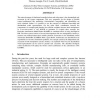Free Online Productivity Tools
i2Speak
i2Symbol
i2OCR
iTex2Img
iWeb2Print
iWeb2Shot
i2Type
iPdf2Split
iPdf2Merge
i2Bopomofo
i2Arabic
i2Style
i2Image
i2PDF
iLatex2Rtf
Sci2ools
DAGSTUHL
1994
1994
A Distributed Control Architecture for Autonomous Robot Systems
The main advantage of distributed controlled robots and subsystems is the decentralized task execution by the system components. This way, properties for the design of flexible control architectures like modularity, fault-tolerance, integrability and extendibility are easily obtained, further it is possible to use the concepts of distributed knowledge and decentralized world representation. On the other hand, coordination between the components, for example path planning for collision avoidance between both manipulators in a two-arm-system, is very difficult to guarantee. To explain these concepts, the Karlsruhe Autonomous Mobile Robot KAMRO is considered which is being developed at IPR. The robot system consists of several subcomponents like two manipulators, hand-eyecameras, one overhead-camera and a mobile platform. Extensions to the distributed control architecture KAMARA (KAMROs Multi Agent Robot Architecture) are described that are responsible to overcome coordination problems, ...
Control Architecture | DAGSTUHL 1994 | DAGSTUHL 2007 | Decentralized World Representation | Task Execution |
| Added | 02 Nov 2010 |
| Updated | 02 Nov 2010 |
| Type | Conference |
| Year | 1994 |
| Where | DAGSTUHL |
| Authors | Thomas Laengle, Tim Lüth, Ulrich Rembold |
Comments (0)

